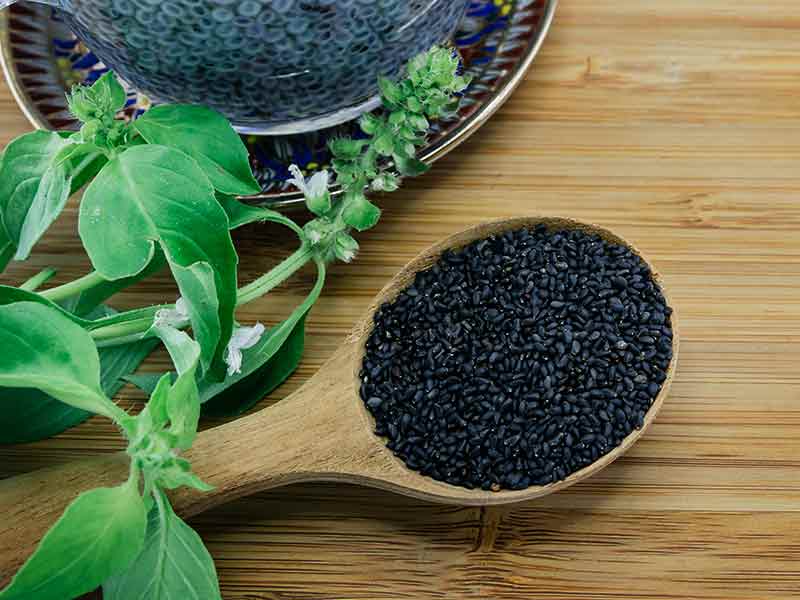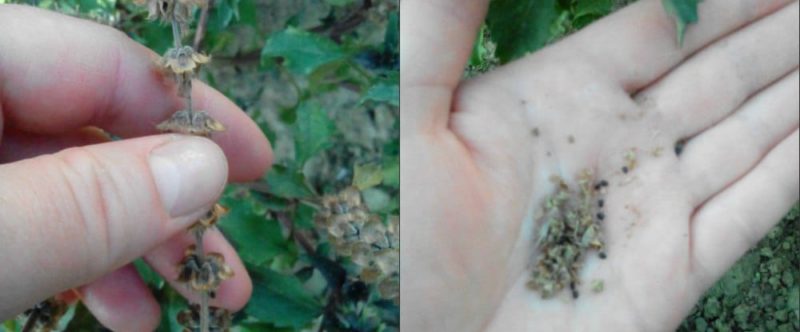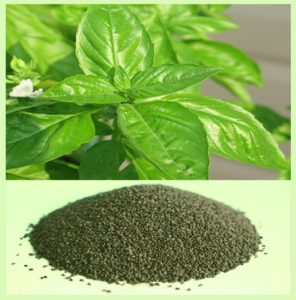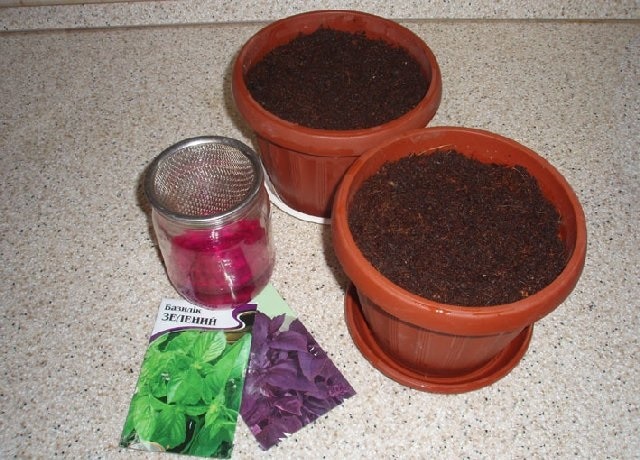How to collect basil seeds and what to do with them next
The fragrant leaves of basil are loved by many lovers of herbs, and a gardener who once planted a plant on his own plot will probably want to do so the next year so that fresh aromatic herbs are always at hand. We will tell you in this article about when and how to collect crop seeds, store and prepare them for planting in order to get healthy shoots in the next season.
What kind of seeds does basil have?

The grains of the plant are located inside the fruits, each of which consists of 4 dark brown seed pods. After maturation, the testes are separated from each other.
The seeds of the crop are small (1000 pieces weigh 0.5-0.8 g), have a teardrop shape and are painted jet black. By appearance the seed basilica resembles sesame, differing only in dark color. The germination of seed material lasts for 4-5 years.
Attention! It is believed that the basil seed has no taste or smell, however, if it can be bitten, the pronounced spicy aroma of the plant will immediately become noticeable.
Grains with a high pectin content, saturated with minerals, vitamins, soluble fiber, essential fatty acids, in addition to seed, have nutritional and medicinal value.
Basil seeds are used as:
- thickener and stabilizer, as well as refrigerant in the food industry and home cooking;
- traditional medicine for colds, depression, gastrointestinal disorders and other ailments;
- an effective supplement to diets for weight loss, quickly causing a feeling of satiety due to the abundance of dietary fiber in the product.
When to Harvest Basil Seeds
The readiness time of seed products depends on a number of factors, namely:
- timing of crop planting;
- climatic conditions of the growing region;
- compliance with plant care recommendations.
Flowers that bloom on the bushes during the appearance of the seeds must be removed so that all the plant’s forces can be concentrated on the ripening of the planting material.
Collect seeds in dry, clear, windless weather. Compliance with this important condition will ensure the safety of seed products both during collection and during subsequent storage. Increased atmospheric humidity leads to the appearance of mold even if the grains are thoroughly dried, so it is better to carry out work in the afternoon, when the moisture has evaporated as much as possible.
Reference. On average, the ripening process of basil seeds occurs in the second half of July - early August. How ready the inflorescences are is determined by the condition of the seeds: if the seed pods have dried and turned brown, then you can begin collecting the seed product.
How to Prepare Basil for Seed Harvesting
To collect planting material of large size and high quality, when growing crops The following recommendations must be followed:
- Pluck the first leaves no earlier than the bush reaches 20 cm in height.
- To stimulate the growth of side shoots, remove the tops of the stems.
- Harvest foliage no more than 3 times, after which the plant is allowed to strengthen and produce large flower stalks.
- Provide the bushes with proper care (water the crop in a timely manner, loosen the soil, fertilize).
After collecting the seeds, basil foliage loses its pleasant taste and is no longer suitable for consumption. Therefore, the plants are harvested in advance and the spicy leaves are either frozen or dried.
How to properly collect basil seeds at home

Starting from mid-July, you should regularly inspect the bushes so as not to be late and remove ripened seeds on time.
How to collect them at home:
- select several faded branches with dried and darkened seed pods;
- the stems are not broken off so that the bush does not dry out, but they are carefully cut with sharp scissors, slightly grabbing the peduncles;
- laid out on a sheet of thick paper or cardboard for further drying.
Location on
To collect basil seeds from your garden plot, a gardener will need:
- sharp garden shears;
- gloves to protect the skin of the hands.
The seed collection process consists of a number of steps:
- Carefully inspect the bushes to determine where the larger seeds are.
- Using garden shears, cut off the selected inflorescences along with the upper part of the peduncle.
- The cut pieces are carefully placed in a box or other container, trying not to shake the testes and not lose part of the planting material.
What to do with them next

Further processing of seed products includes 3 main stages:
- selection;
- drying;
- separation of planting material from the seeds.
Selection
Process description:
- The collected raw materials are carefully inspected.
- Select inflorescences that have large seed pods, dry, dark brown in color.
- Selected specimens are tied into tight bundles of 6-8 pieces.
Drying
Drying seed stocks before threshing and subsequent storage is a mandatory procedure that is carried out regardless of the weather in which the material was collected.
Attention! Dry the collected basil inflorescences in a dry, well-ventilated area, without direct sunlight, to protect the seeds from drying out and reducing germination.
They do this as follows:
- They stretch a rope under the ceiling.
- Bunches of grass are hung with their heads down so that the distance between them is 3-5 cm.
This will ensure that each inflorescence dries evenly.
Alternative option:
- Place parchment paper or cardboard on baking sheets.
- The raw materials are evenly laid out in one layer on baking sheets, without being combined into bundles.
- For the process to be successful, carefully turn the workpieces 2-3 times a day.
The following are great places to dry:
- attic;
- glazed balcony;
- veranda.
You can also dry them outdoors - under a canopy or on an unglazed balcony, but then the plants will have to be moved indoors at night so that the seeds do not absorb moisture.
The process continues for at least 2 weeks.
How to thresh seeds
Algorithm:
- Dried testes are placed in a linen bag.
- Carefully tie the neck.
- Take a wooden stick and gently tap the surface of the bag for 8-10 minutes. It is allowed to carry out the procedure by hand.
- The seeds, along with the dust, are poured into a sieve with large mesh.
- Particles of testes and debris are selected manually.
- Carefully winnow the seed material.It is better to do this outdoors in windy weather.
Do not rub dried inflorescences with your hands - this can cause irritation and even damage to the skin.
You can separate the seed from the seeds using a sieve and pestle:
- Place the dried preparations in a sieve.
- Gently rub the inflorescences with a pestle for 1-2 minutes.
- After this, unnecessary particles are removed and the procedure is repeated again.
- They do this several times.
- The remaining raw materials are winnowed.
The planting material is dried again in a warm room with low air humidity:
- spread the seeds in a small layer on baking sheets lined with paper or thick sheets of cardboard;
- dry for 2-3 days, turning occasionally and immediately removing damaged grains.
How to store prepared basil seeds
Mistakes made when storing planting material will inevitably lead to damage to the seeds, deterioration in their germination and reduced yield. Following a number of simple rules will help protect seed products from drying out, mold and rotting.
Store grains in a dry, dark place at room temperature for 3-4 years. This is the period during which the planting material does not lose its viability.
Attention! To prevent basil seeds from suffering from a lack of fresh air and starting to rot, you should not store them in plastic bags or tightly closed plastic containers.
For these purposes it is recommended to use:
- canvas bags;
- carton boxes;
- bags made of thick paper.
The most reliable storage method, ensuring the longest shelf life of seed products, is special packaging with a foil layer without damage.
To avoid unpleasant surprises before sowing, it is necessary to periodically check the condition of the grains. If you find that the seeds are damp, you should immediately:
- pour them onto a clean sheet of thick paper or a paper towel;
- Place to dry in a place away from heat sources and inaccessible to direct sunlight.
Preparing basil seeds for planting

If all recommendations were followed when collecting and storing seed products, shoots will sprout smoothly, and each grain will produce a full-fledged sprout.
As spring approaches, gardeners check seeds collected on their own for germination. This is done at the end of January - beginning of February, and for planting it is recommended to use not last year’s grains, but material from two years ago:
- Seeds are selected in quantities of 20-25 pieces.
- Prepare a container filled with a light nutrient substrate so that 3-4 cm remains to the edge.
- Selected and counted grains are sown into the pre-moistened soil mixture, deepening each grain by 1 cm and maintaining an interval of 1-2 cm between them.
To speed up seed germination, cover the container with the plantings with glass or build a polyethylene greenhouse over it, and then place it on a warm (with an air temperature of about +25°C) and well-lit windowsill. Shoots are expected in 7-8 days. As soon as sprouts appear, the glass or film is removed.
Important! Before landing Be sure to count the grains to accurately determine germination.
Seedlings, the number of which determines the germination of planting material, after 3-4 weeks dive into separate small containers and used later as early seedlings.
Even with high germination, the usefulness of all seeds is not guaranteed. Before planting, a procedure for separating low-quality specimens is carried out:
- All grains are placed in a container and filled with warm water.
- Leave for 15 minutes.
- Spoiled and dry seeds rise to the surface, while good ones sink to the bottom.
- The water along with the unusable grains is drained, and the rest of the material is dried for 1.5-2 hours.
In order for the selected high-grade seeds to germinate as quickly as possible, they are subjected to additional processing:
- Warm up for 3 hours at a temperature of about +40°C.
- Wrap in a piece of gauze or moisture-permeable fabric.
- Fill with water heated to +40°C.
- Place in a warm place for 1-2 days.
- Change the water every 10-12 hours.
- Immerse for 2 hours in a pale pink solution of potassium permanganate for disinfection.
- Place on several layers of gauze to dry.
Before planting, hatched grains can be treated with a growth stimulator by wrapping them in fabric soaked in the product and leaving them for 1 hour.
Conclusion
A competent approach to collecting and storing basil seeds growing in a country house or garden will ensure the receipt of high-quality planting material with high germination rates.
Proper preparation for planting will allow the seeds to bring a good harvest of fragrant foliage, which will give any dish an unforgettable, original taste.